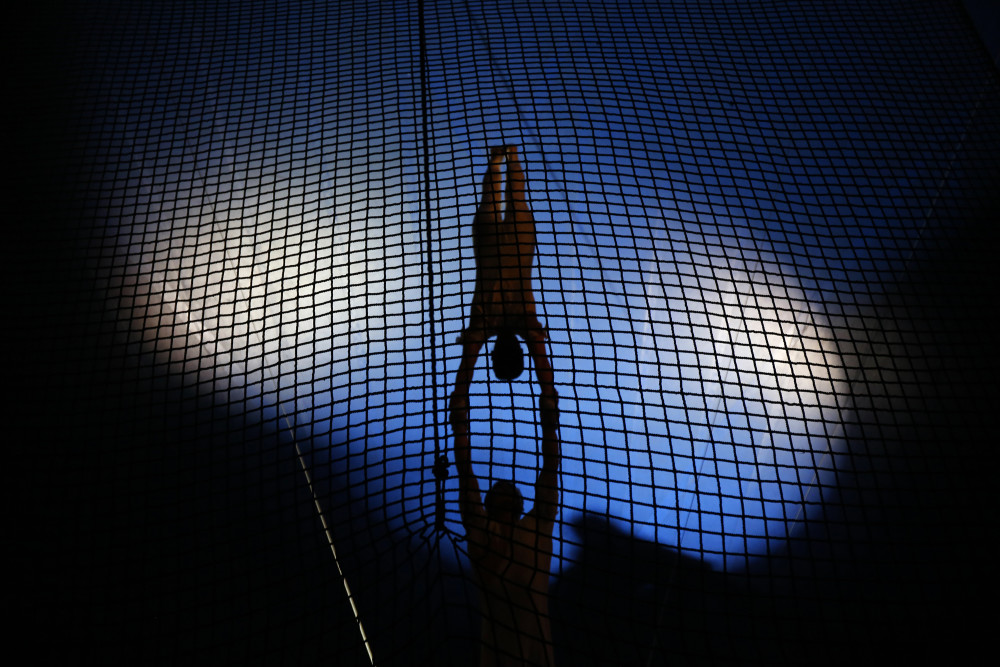By Gregory Pratt
Chicago Tribune.
CHICAGO
People don’t believe I’m afraid of heights. They’ve seen too many photos of me upside down in midair, flying on a trapeze.
Those pictures lie. Every time I climb the ladder at TSNY Chicago, a school that teaches trapeze and other aerial acts where I take classes, I briefly wonder if I’ve lost my mind.
“You don’t even like heights,” the voice inside my head repeated the first time I climbed the rickety ladder and walked onto the ledge. I’ve had that same thought on rooftops and roller coasters, but I can’t resist.
Nor am I alone in pursuing leisure that, on some level, terrifies me.
“Over half the people that come to trapeze tell me they’re afraid of heights, which I find a little mind-boggling ’cause it’s like, if you’re afraid of heights, what made you think it’s a good idea?” said Birgit Spooner, a senior instructor at TSNY Chicago.
“A lot of them say it’s a way to try and overcome it in a somewhat safe environment,” she added.
That’s me, too.
I started taking classes after hearing about the school from a co-worker’s friend at a birthday party, curiosity piqued.
I had thought that was the kind of thing you could only learn as a runaway or at a school for gifted children.
I remember standing on the board my first class, arm out to reach the trapeze swing 25 feet in the air, knees wobbling like a bad dance move.
The bar pulled me forward, heavier than expected. I jumped. The rest is a blur of gravity and time. I recall my teacher’s words from that class as I kept rushing through the beginner’s trick, which is called a knee hang: knees up, arms down, lean back and reach.
“You did everything all at once,” the instructor said, “and whenever you wanted to.”
Not good. That’s another sign of fear: You stop listening.
“I’ve noticed people that are really nervous, they don’t listen,” Spooner said. “Because they have so much going on in their head, and all of that chatter in their head is a lot louder than we are.”
After a bunch of classes, flying doesn’t freak me out as much as it did in the beginning. But my heart still pitter-patters as I stand on the ledge for my first jump of the day.
What keeps me coming back is this: I believe it makes you a better person to do things you’re afraid of, aren’t good at or barely understand. Especially when it’s all at once.
It helps, too, that the people at TSNY Chicago are kind, patient and generous with their feedback.
Most classes I’ve been to feature a bunch of first-timers, ranging from adventure-seekers to men dragged there by their girlfriends, who are supportive of each other.
Some people will walk around the floor saying there’s “no way” they can pull off the basic trick. Their eyes pop when they learn that they’re going to be caught by someone on the other swing. By and large, though, people cheer each other on.
“We get classes where people clap for everybody every turn, even if they did it completely wrong,” Spooner said.
There are times when a student will struggle to hit the trick until the very end, but when they do hit it, she said, “the whole class will go nuts cheering, and that’s awesome.”
For me, that camaraderie is a large part of the appeal. Watching strangers support one another is a welcome escape from our too-often-cruel world.
It hasn’t all been good feelings and self-improvement. Every class leads to new bruises, sometimes in unexpected places.
I’ve had a mishap or two, like the time I unfolded too early for a trick and slammed into the catcher midair. (I haven’t seen anyone else manage that.)
Or the time I thought I was going to nail a new trick, screwed up at the last second and cursed at the top of my lungs as I fell into the safety net.
(There were, I’m sorry to report, children present.)
But I don’t do trapeze because I want to join the circus. I do it because I’ve learned new things about the world, including that people can learn things if they just try.
A few days ago, as I climbed the school’s ladder, I noticed that someone had taped words of encouragement beside several rungs on the way up.
The message starts: “I want to do it.” Then it’s: “How do I do it?” Followed by: “I’ll try to do it.” That leads to: “I can do it.” After: “I will do it.” At the top: “Yes, I did it!”
Isn’t that what life is all about?














































































































































































































































































































































































